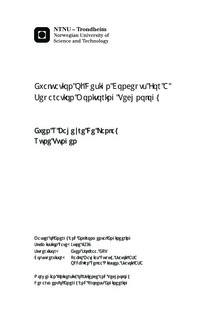| dc.description.abstract | Current wet gas meters used by Statoil can detect liquid volume fractions (LVFs) over 5%, but not smaller fractions. This means that there are currently no technologies capable of monitoring separation performance. It is in Statoil s interest to measure and monitor the separation performance, since too high LVFs can damage downstream process equipment and increase the risk of hydrate formation.
This thesis performs an early study of a new technology for separation performance monitoring. It is based on sound measurements and the influence of liquid on sound wave propagation, i.e. acoustic damping. Other studies have showed that introducing liquid in a gas increase the attenuation of the sound amplitude.
Two different design concepts were investigated: a corrugated pipe and a smooth pipe with a loud speaker. The corrugated pipe is capable of generating sound without external sources. When gas flows through a corrugated pipe, it induces vortex shedding in the cavities. At high enough flow velocities, the frequency of the vortex shedding couples with the pipe s natural frequency. This results in a high tonal sound, or whistling. A phenomenon usually dubbed "singing riser" in the oil and gas industry as it occurs in the flexible risers transporting hydrocarbons from the seabed to the sea surface. The smooth pipe, however, has no self-generating sound source and hence a loud speaker is needed to create sound.
The design concepts are approached theoretically, by modelling and by experiment. A one-dimensional flow-acoustics model was simulated in COMSOL Multiphysics. The model failed to return realistic sound pressure levels but captured the physical phenom- ena occurring in a corrugated pipe well. For instance, it predicted the first mode of the pipe s natural frequency accurately.
The two designs concepts were tested experimentally for different flow rates and different liquid rates. The experiments strongly indicated an added acoustic damping due to liquid, even for LVFs much lower than 1 · 10−4, and thus the main principle of the technology was supported. However, the experiment could not reveal any significant advantages in measurement accuracy for either a smooth or a corrugated design. | |

